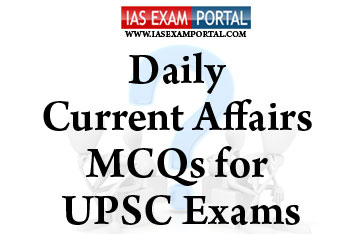(HOT) UPSC Current Affairs 2025 PDF
NEW! The Gist (NOV-2025) | E-BOOKS
Current Affairs MCQ for UPSC Exams - 05 February 2020

Current Affairs MCQ for UPSC Exams - 05 February 2020
Q1. Which of the following statements regarding thethe Integrated Child Development Services(ICDS) scheme and its implementation stands true ?
1) Anganwadis or day-care centres are set up under the Integrated Child
Development Services (ICDS) by the Women and Child Development Ministry to
provide a package of six services.
2) The aim of the scheme is to reduce infant mortality and child malnutrition.
Beneficiaries include children in the age group of six months to six years, and
pregnant women and lactating mothers.
3) As per Census 2011, 32% of India’s 1.2 billion population live in cities and
hence majority of the beneficiaries of the scheme are in urban centres.
a) 1 & 2 only
b) 2 & 3 only
c) 1 & 3 only
d) all of the above
Q2. The Eat Right India movement which is a crucial preventive healthcare measure to trigger social and behavioural change is aligned with which of the following flagship programmes of the central government ?
1) PradhanMantriMatruVandanaYojana
2) POSHAN abhiyaan
3) Swachh Bharat Mission.
4) KishoriShakthiYojana
5) Ayushman Bharat Yojana
a) 1,2 & 3 only
b) 2,3 & 5 only
c) 1,3 & 5 only
d) 2,4 & 5 only
Q3. The Supreme Court has directed the states, which are yet come out with notifications for establishing Gram Nyayalayas, to do so within four weeks recently.
1) Gram Nyayalayas were established for speedy and easy access to the justice
system in the rural areas across the country under the gram nyayalayas act 2008.
2) The Gram Nyayalayas are presided over by a Nyayadhikari, who will have the
same power, enjoy same salary and benefits of a Judicial Magistrate of First
Class.
3) Gram Nyayalayas has been given power to accept certain evidences which would
otherwise not be acceptable under Indian Evidence Act.
a) 1 & 2 only
b) 2 & 3 only
c) 1 & 3 only
d) all of the above
Q4. Cabinet will be taking up the proposal to amend the Disaster Management Act of 2005, which largely focuses on improving preparedness, providing immediate relief, and protecting infrastructure. Which of the following statements regarding the act stands true ?
1) The Disaster Management Act was enacted to effectively prevent, mitigate
and prepare for disasters and came into being on the heels of three major
disasters in the Indian subcontinent: the 1999 super cyclone in Odisha, the 2001
Bhuj earthquake, and the 2004 Indian Ocean tsunami.
2) The Act mandated the creation of the National Disaster Management Authority
and State Disaster Management Authorities only while neglecting the district
disaster management authorities.
3) The Act’s enormous emphasis on preparedness has translated into timely
warnings, relief shelters and massive evacuation exercises. All these steps have
reduced casualties.
a) 1 & 2 only
b) 2 & 3 only
c) 1 & 3 only
d) all of the above
Q5. Which one of the following cities have been awarded the UNESCO world heritage site tag recently for its grid plan based architecture and buildings? The city was built by Sawai jai Singh II in the year 1727 with large public squares called ‘chaupars’ as well.
a) Jaisalmer
b) Lucknow
c) Jaipur
d) Ahmedabad

